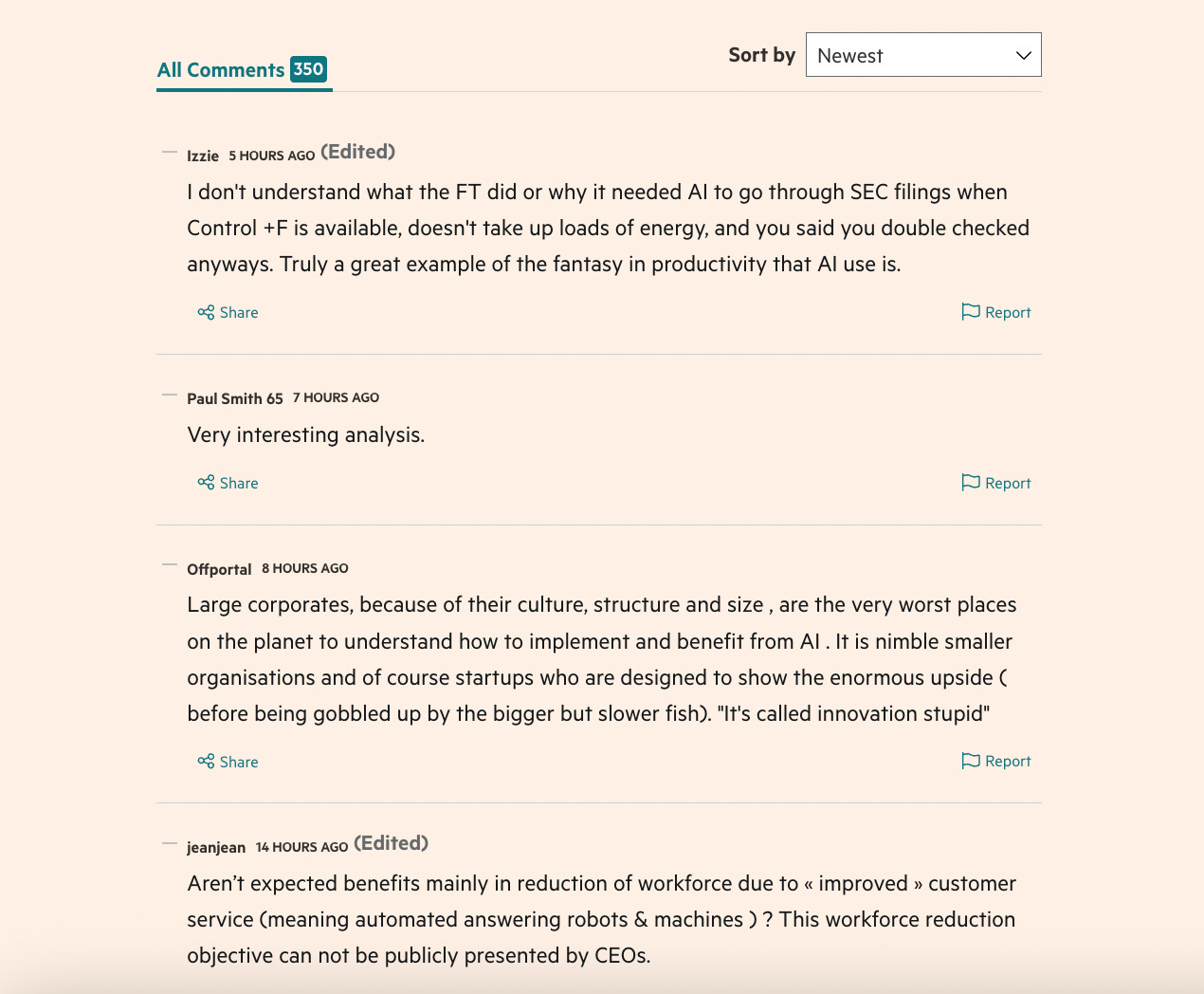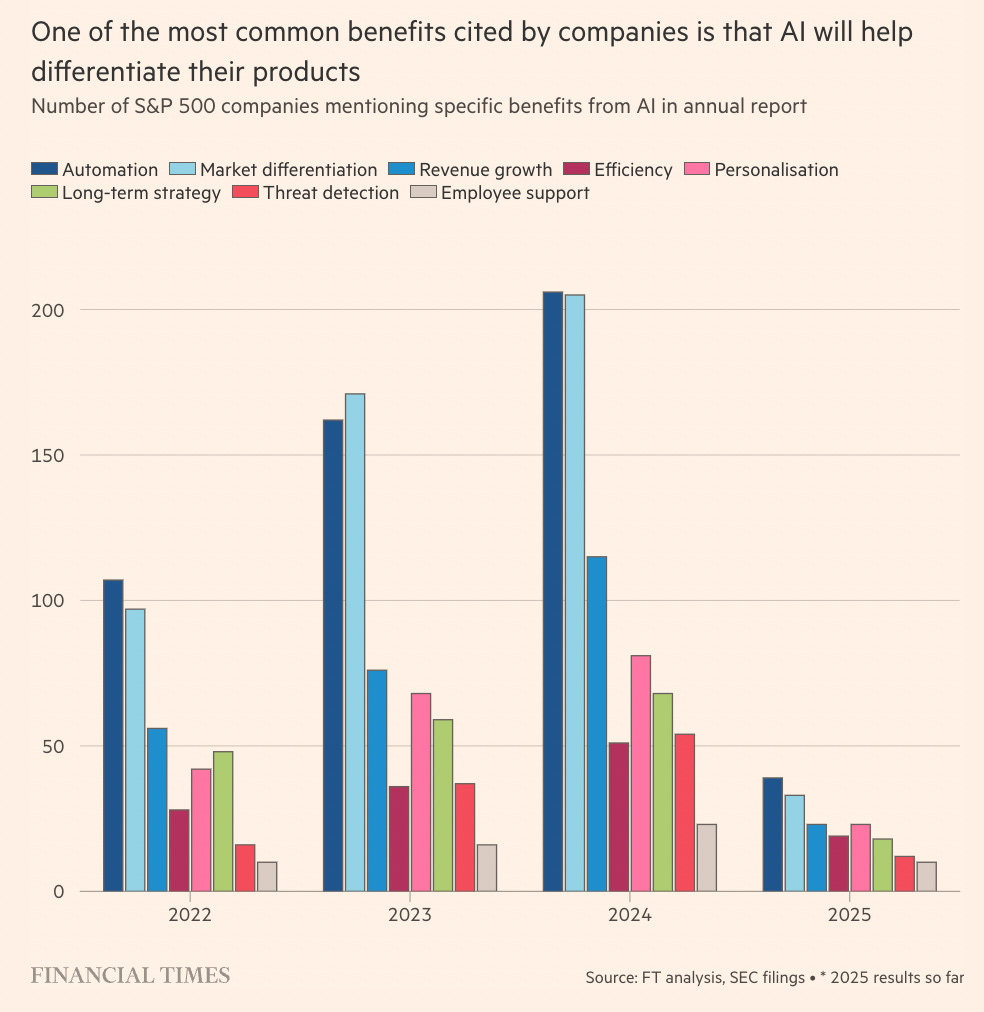Where should AI productivity gains actually go?
Exploring how to move from Shadow AI to Shared AI
I’ve been back in the comments section this week.
In particular, this from someone quoting their CEO below a Financial Times AI article:
“Even if workers are 20% more efficient, how do I know that freed up time will go into more work to increase output?”
Notable because I’ve been asked a variation of this numerous times by CEOs and other business leaders over the past few months. And while it’s a perfectly reasonable question – “how can we actually realise productivity gains from our team using AI?” - it also reveals something most leaders haven’t considered.
The important role of human nature in AI adoption.
Specifically, if people think sharing their AI productivity gains will just result in more work being dumped on them, they’ll keep those gains secret.
According to MIT’s recent research, while 90% of employees use AI regularly, only 40% of companies provide it. In other words, your staff already use AI. They just don’t use yours.
This is Shadow AI in full effect.
In this case, people - who often already feel overworked - have discovered AI can make them more efficient. But they’re not telling anyone. They’re learning to keep AI efficiency improvements to themselves. The business gets zero benefit.
This is a hot topic in the companies I’m working with – how can we transform Shadow AI into Shared AI?
Well, first understand the reasons, starting with the one we’ve already uncovered.
Incentives: there’s no upside to sharing efficiency gains
Policy: they’re not really sure what they can and can’t do
Perception: they’re under the misapprehension that using AI reflects an inability to their job effectively, rather than a welcome opportunity to innovate
Capability: they recognise that the tools they’re using personally are better than the solutions the company is mandating
Understand these points and you can start tackling Shadow AI.
First, the easy bit. Create a clear policy that everyone understands outlining what people can and can’t do. The things to watch out for. The behaviours you encourage.
Then, ideally, buy the tools your people are already using. If 90% of your team are on ChatGPT, get ChatGPT for Business. Stop forcing them to use inferior enterprise apps while they sneak around with the good stuff.
Again, this is a story I hear again and again.
An agency I was with the other day spent considerable time and money creating their own internal AI. Yes, it’s secure, but objectively – judged by the team’s usage – it’s not very good. So, everyone either just uses their own accounts anyway (meaning the data security concerns you’re trying to avoid are happening anyway - just without visibility or control). Or, worse, they don’t really use AI at all.
Next, make AI fluency part of your culture, not a secret. Create channels where people share what works. Run internal sessions on prompting techniques. Celebrate AI experiments - even if they don’t always go perfectly to plan.
And how about those productivity gains?
Well, here’s a simple idea: split the savings with them.
If someone saves 20% of their time through AI, redeploy 10% of their time back into additional work but let them keep the remaining 10% for learning, skill development, or more AI experimentation. Crucially, let them decide where to focus. You’ll get a dual benefit - more willingness to innovate and share in the first place, and more incentive to continue pushing to improve.
The problem underlying all of this is that most companies haven’t considered much beyond “we should do something with AI.” The result is that they’re struggling to see the promised benefits.
That CEO comment at the top was from an FT article on this very subject.
They analysed 374 S&P 500 companies that mentioned AI last year. 87% of earnings calls were positive. But their regulatory filings told a different story: vague productivity claims, pilots that deliver nothing measurable.
The truth is that the secret to success here is really no different from any major technological transformation. It’s the boring stuff that makes the difference.
Clean data.
Clear processes.
People who understand what they’re trying to achieve.
Incentives that reward efficiency rather than punish it.
So, consider the basics before investing more time and money into your AI strategy.
1. What specific problem or opportunity are you focused on?
2. How will you measure success?
3. Where does the saved time go?
You can keep wondering where the productivity gains went, or you can design incentives that make people want to share them.
See you next week.
Ollie




